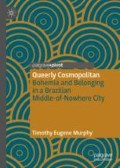Abstract
The chapter deals with bohemians’ intimate friendships that take place beyond the bounds of nocturnal bohemia and entail an unusual amount of attention to same-sex romances and sexual relationships. The chapter analyzes the kinds of practices and discourses that thrive in these kinds of friendships and considers how they structure and are structured by the bohemian community as well as mainstream society. By reserving talk about same-sex sexuality to intimate moments among close friends, bohemians are able to realize a specific politics of queerness that allows them the opportunity to construct lives for themselves that are not over determined by a fixed sexual identity. The chapter underscores how these fringe moments of intimacy ultimately work to sustain the bohemian community’s queer form of cosmopolitan belonging.
Access this chapter
Tax calculation will be finalised at checkout
Purchases are for personal use only
Notes
- 1.
Bicha refers to a gay man but has no adequate translation in English. Unlike viado, which probably translates best into English as “fag/faggot” and is used most often by nonqueer people as a derogatory term for such men, bicha—literally meaning “female animal”—is employed in communities of same-sex desire throughout Brazil, connoting the effeminate “nature” or performances of gender/sexuality of gay men.
- 2.
The “galera” refers to the clique of people who come together to form Teresina’s nocturnal bohemia (Chap. 4).
- 3.
It is widely accepted that numerous participants in the galera do not engage in same-sex sex or romantic relationships. However, because the majority does, and because I was most directly exposed to such participants, I have come to see these intimate moments in terms of a shared subjectivity around same-sex desire. Indeed, intimate moments exist among close friends who share opposite-sex desires as well as those who do not share sexual desires. However, such moments are not my focus here.
- 4.
As I explain in Chap. 4, GLS is an acronym that came out of an identity politics movement to institutionalize gay spaces as not exclusively “Gay” or “Lesbica,” but also “S,” which stands for “simpatizantes,” or “sympathizers.”
- 5.
It is important to note that many Teresinenses who employ participants in the galera for their avant-garde aesthetic expertise are not oblivious to the fact that some of these men and women engage in same-sex practices and relationships. It is even possible that this knowledge contributes to clients’ confidence in their employees’ ability to execute the task at hand. Be that as it may, many clients still consider it out of place for their employees to be overly explicit about their same-sex desires. At the end of the day, it is important for many clients that their employees maintain a respectable middle-class public image, which leaves little room for nonnormative gender/sexual identities.
- 6.
Forró is a genre of traditional northeastern music whose base components are the accordion, a special drum, and a metal triangle.
References
Boellstorff, Tom. 2005. The Gay Archipelago: Sexuality and Nation in Indonesia. Princeton: Princeton University Press.
DaMatta, Roberto. 1991. Carnivals, Rogues, and Heroes: An Interpretation of the Brazilian Dilemma. Notre Dame: University of Notre Dame Press.
Donham, Donald. 1998. Freeing South Africa: The “Modernization” of Male-Male Sexuality in Soweto. Cultural Anthropology 13 (l): 1–19.
Fry, Peter, and Edward McRae. 1983. O Que É Homossexualidade? São Paulo: Brasiliense.
Halberstam, Judith. 2005. In a Queer Time and Place: Transgender Bodies, Subcultural Lives. New York: New York University Press.
Manalansan, Martin F.I.V. 2003. Global Divas: Filipino Gay Men in the Diaspora. Durham: Duke University Press.
Newton, Esther. 1972. Mother Camp: Female Impersonators in America. Chicago: University of Chicago Press.
Parker, Richard. 1999a. Beneath the Equator: Cultures of Desire, Male Homosexuality, and Emerging Gay Communities in Brazil. London: Routledge.
———. 1999b. ‘Within Four Walls’: Brazilian Sexual Culture and HIV/AIDS. In Culture, Society and Sexuality: A Reader, ed. Richard Parker and Peter Aggleton. London: UCL Press.
Author information
Authors and Affiliations
Rights and permissions
Copyright information
© 2019 The Author(s)
About this chapter
Cite this chapter
Murphy, T.E. (2019). Friends of Dusk and Dawn. In: Queerly Cosmopolitan. Palgrave Pivot, Cham. https://doi.org/10.1007/978-3-030-00296-1_6
Download citation
DOI: https://doi.org/10.1007/978-3-030-00296-1_6
Published:
Publisher Name: Palgrave Pivot, Cham
Print ISBN: 978-3-030-00295-4
Online ISBN: 978-3-030-00296-1
eBook Packages: Social SciencesSocial Sciences (R0)

